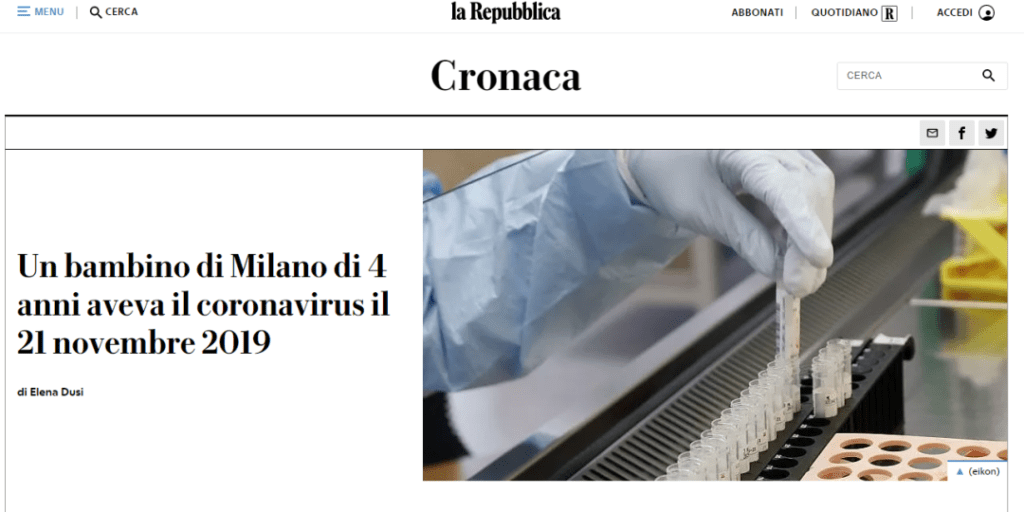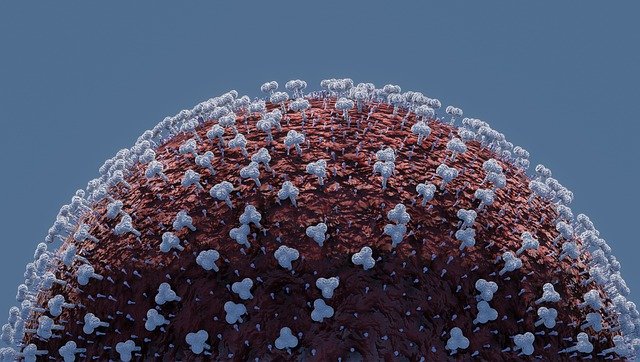According to Italy’s newspaper Republic, a child in the country developed symptoms such as cough, rhinitis, respiratory tract infection and rash at the end of November last year, and collected throat swab samples on December 5 last year.
Now that the researchers in the country have tested the sample collected in early December last year, they have detected the RNA sequence of the novel coronavirus.
At present, this discovery has been published in the academic journal Emerging Infectious Diseases of the United States Centers for Disease Control and Prevention.
In view of the fact that there are still a large number of rumors, rumors and even false information about where the novel coronavirus came from on the Internet at home and abroad, Geng Zhige immediately found the original report to verify the original report after seeing the news from Italy on the first domestic website.
After verification, we can confirm that the Italian newspaper La Repuberan did report on the matter, and this discovery was indeed published on the website of the medical journal Emerging Infectious Diseases, which is affiliated with the Centers for Disease Control and Prevention, as shown in the following figure below:

After reading the Italian media report and the original text of the website Emerging Infectious Diseases, we can further confirm that scholars from the University of Milan in Italy did find that there is a COVID-19 R on it after monitoring a throat swab sample collected on December 5 last year. NA sequence.
In an article published in Emerging Infectious Diseases, these scholars said that they had genetically sequenced the sample in the throat swab in a laboratory at the university that met the relevant standards of the World Health Organization.
Italy’s newspaper Republic stressed in particular that although no test is 100% accurate, this test is much higher than antibody tests that were easy to mistake other coronavirus infections for COVID-19 infection before.
More importantly, according to Italian scholars who participated in the study, the sample comes from a four-year-old child who had cough and rhinitis since November 21 last year.
The scholars said that the child lived in the area around Milan and had not reported a travel history. After the case appeared on November 21, the child was sent to the hospital for emergency treatment due to respiratory infections and vomiting on November 30, and a measles-like rash appeared on December 1.
Therefore, on December 5, 14 days after the child first developed symptoms, the hospital sampled the child’s throat swab on suspicion of measles.
Although Italian scholars who report this discovery today do not disclose whether the hospital found and reported the “unknown virus” that we now identify as COVID-19 after collecting the sample, these scholars said that they are testing the sample now because they have passed the epidemic. The disease detection network found that a group of suspected measles symptoms were eventually negative at the end of last fall, so these scholars decided to re-test these samples from the perspective of COVID-19 to see if there were any new discoveries, and such a special case was found.
They also said that they checked the result repeatedly to confirm that the sample was positive. But this situation does not occur in other samples of measles cases that they have been re-tested many times.
However, although these Italian researchers believe that this discovery indicates that the novel coronavirus may have appeared in Italy as early as late last autumn, and the discovery has “important epidemiological significance”, because of the low quality of the sample, they are unable to genetically sequence the virus in the sample in a wider area.
It is impossible to determine whether the virus is imported locally or from abroad, and the connection of the virus to the novel coronavirus that later became popular in Italy.
But now that Italy has now obtained a positive sample of COVID-19 from a suspected disease that appeared on November 21 last year – even if it was obtained on December 5, 14 days later – this is still higher than Wuhan, China, who was found to have “unexplained pneumonia” after the illness on December 8 last year. The “earliest” case reported by the aspect is earlier.
It is worth mentioning that the case of December 8 has not been to the South China Seafood Market.
Therefore, as we introduced earlier, given that the gold content of this discovery obtained by Italy through gene sequencing is much higher than that of previous antibody tests, Geng Zhige believes that the World Health Organization, which is currently carrying out virus traceability, should make Italy’s 4-year-old man. The area from which the case came is also included in the scope of work.
However, this is by no means what some Western media publicize about China’s “shirking responsibility from the source of the epidemic”.
In fact, we believe that the world should make it clear that where the virus comes from is a serious scientific question, which should be scientifically explored, not involving politics, let alone becoming the material for political slander of certain countries and other countries.
Well, scientifically speaking, although the previous evidence shows that Wuhan was the first place to be hit by the epidemic, with the new evidence now showing that the time of COVID-19 cases appeared in relevant areas of Italy, earlier than the first publicly recorded in Wuhan, Italy should become a destination for traceability work.



